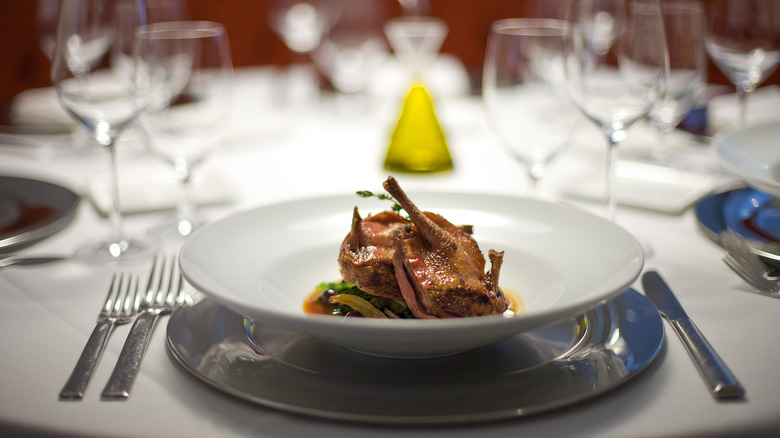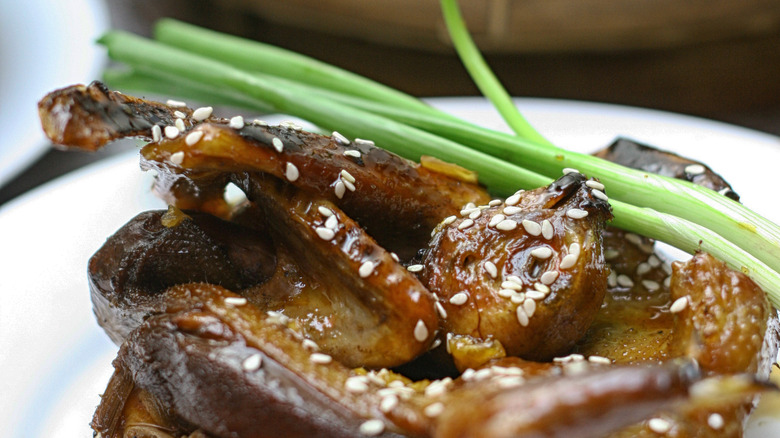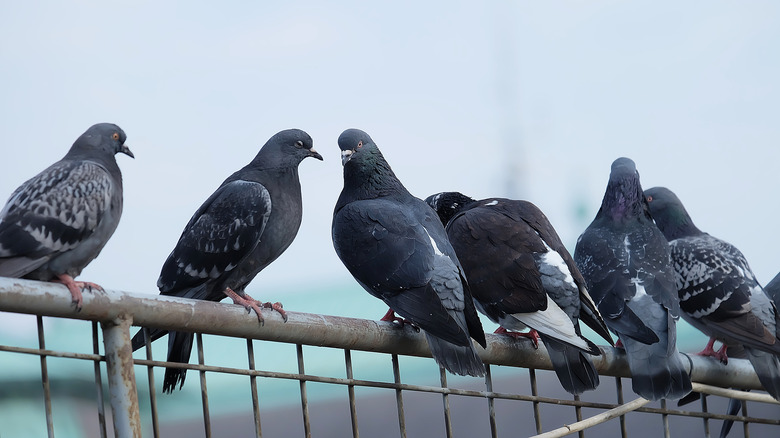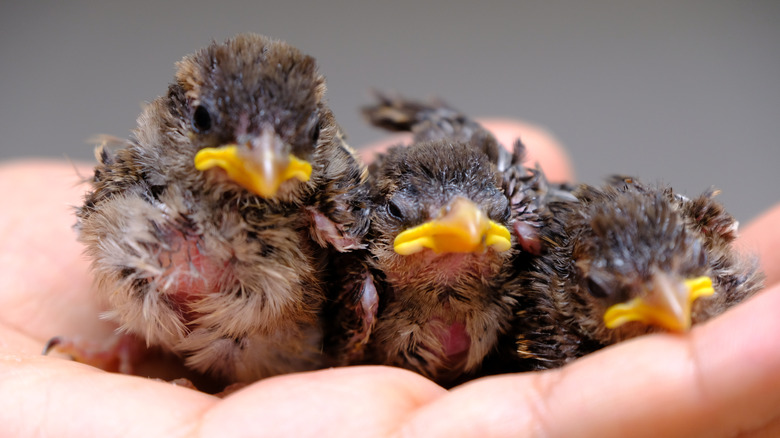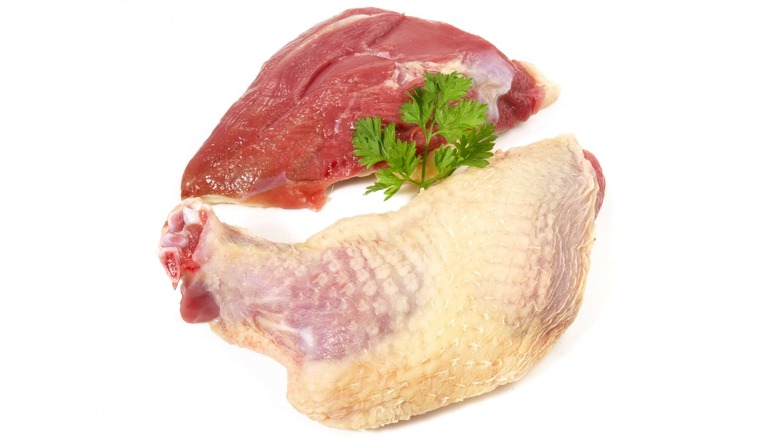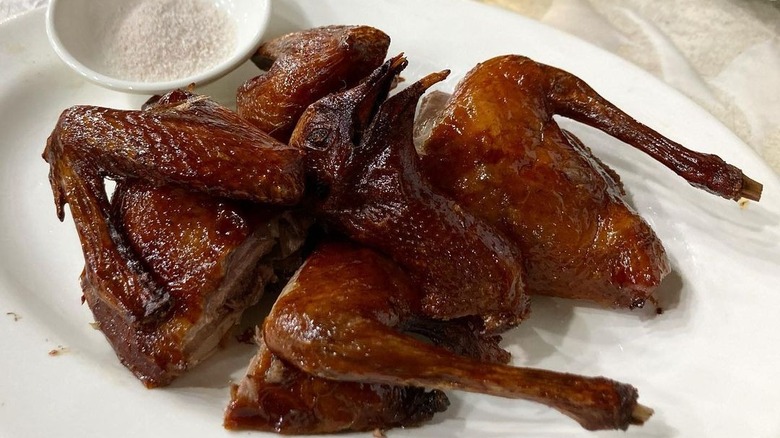What Is Squab And How Do You Eat It?
A mystery for some and an avian delight for others, squab very well may be "the other, other, other white meat." Often relegated to being served at fine-dining establishments, squab pales in comparison to the popularity of other edible birds such as chicken, turkey, duck, and even quail.
Believe it or not, squab is a form of pigeon. Yes, do not adjust your screen brightness or your glasses — you read that correctly. While the notion of eating pigeon may not be the most appetizing thing you've ever heard, don't let that imagined stigma negatively influence your opinion of the small bird. Squab is typically around four weeks old and is specifically raised for eating. D'Artagnan notes that squab was actually the "first domesticated poultry, even preceding chicken." Isn't that fascinating? You learn something every day.
What does squab taste like?
Squab has a darker color, more like duck than chicken. It is cooked like beef or other "red meat" — from medium-rare to medium-well — and is tender and relatively mild. It is often roasted whole and then broken down, but it's also sometimes stuffed prior to cooking. It has a slightly gamey taste, and the birds are quite small. Most squab is from birds that never flew, hence their tender meat.
From a sustainability and animal welfare perspective, squab eaters can rest assured that the birds they're feasting on were probably raised well, as they are rarely ever mass-produced.
Still, there remains an aversion to squab. Food & Wine notes that some of the reasons for squab's stigma are that they are more expensive than other poultry — and the simple fact that many people associate pigeons with a lack of cleanliness. While squab was popular in the past, as Popular Science notes, people these days equate pigeons with the birds found in cities, leaving their poop everywhere.
What is the history of squab?
Throughout history, though, squab was a highly favored protein source and was said to have first been eaten in ancient Egypt. Popular throughout many countries and cuisines, a properly cooked squab can become an extremely enjoyable meal. From Italy and Morocco to North Africa, people have been eating squab since as early as the 15th century, often in phyllo pies, cooked over a roaring fire, or enjoyed with rice, according to D'Artagnan.
In addition, the small birds were more than just a dinner option — they acted as messenger pigeons! Of course, prior to mail, the internet, and phones, these messenger pigeons were valued and incredibly respected. Popular Science even highlights a particular domesticated pigeon named Cher Ami who was actually gifted a French military honor called Croix De Guerre, after delivering an enormously important note during World War I.
How is squab raised?
Raising baby pigeons is much more labor-intensive and time-consuming than raising any other form of poultry, so the majority of squab is purchased from reputable, small purveyors. Some of the reason for the high price point is that, as D'Artagnan founder Ariane Daguin noted when speaking with Food & Wine, raising squab is "much, much more intensive than any other poultry." According to Popular Science, baby pigeons must be raised in close proximity to their parents and given a great deal of attention, since they're essentially entirely helpless as newborns. This reduces the amount of offspring most pigeons are able to have. In addition, the birds themselves are so small and don't yield nearly as much meat as other poultry. The birds can also be very sensitive and are very resistant to poor food, a change of environment, or artificial insemination. Altogether, this boosts the price point.
Many note a resurgence within the past decade or so, though, with many restaurants selling more squab and many food-centric patrons opting for the more unusual option over the more ubiquitous chicken breast or thigh. This has resulted in squab becoming an elevated, almost-luxury protein option. While many only enjoy squab when eating out, you can certainly make it at home — just be sure not to overcook it! As mentioned previously, cook squab like you would cook red meat. When properly prepared, it can be an unforgettable dining experience.
How is squab cooked?
The Woks of Life notes that the majority of squab sold in the U.S. is sold frozen or partly frozen, and it is imperative to properly clean and break down the bird prior to cooking and eating. This involves removing the organs, cleaning with lots of cold water, and even sometimes cutting off talons or claws. Of course, depending on where you source the squab from, this may have already been done for you prior to purchasing.
Squab can be cooked whole or broken down into parts prior to cooking. It is often grilled, sautéed, roasted, grilled, stuffed, braised — or even deep-fried. Woks of Life also shares a stunningly impressive recipe of a deep-fried whole squab that would be the absolute star of any holiday spread. Like all poultry, the breasts, legs, and thighs can all be consumed. Squab can be purchased from specialty butchers or farmers' markets, as well as through various online meat vendors. Some local farms may also sell squab. It's rare to find squab at mainstream grocery stores, though.
Nutritional information about squab
Squab is a great source of protein and boasts tons of vitamins and minerals, including thiamin, folate, and potassium (via University of Rochester Medical Center). Of course, the manner in which it's cooked also impacts the overall nutritional makeup — a deep-fried bird will be different from grilled squab. In addition, sugary marinades or glazes will also make for a more caloric meal than a simple preparation of oil, salt, and pepper. As Nutritionix notes, squab is also a great source of vitamins A and C, as well as calcium and iron. On the flipside, squab does contain a good amount of saturated fat and cholesterol. However, removing the skin prior to cooking or eating can help to significantly reduce these.
Another difference between squab and other poultry is that it is always sold whole, whereas chicken, turkey, and even duck are often sold in parts. This also affects how the bird is eaten — for instance, while someone may eat a boneless, skinless chicken breast, that generally won't be the case when it comes to eating squab, which is generally consumed bone-in, skin-on, and both white and dark meat.
